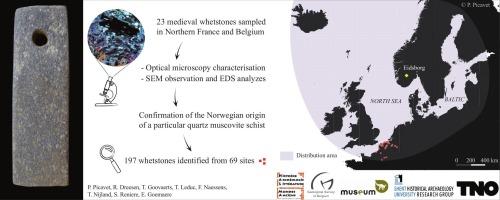中世纪和近代斯堪的纳维亚商品的流动:法国北部、比利时和荷兰的挪威磨刀石鉴定
IF 1.5
2区 历史学
0 ARCHAEOLOGY
引用次数: 0
摘要
从法国北部和比利时的中世纪遗址中采集的几个系列的磨刀石样本显示(全部)存在来自挪威的标本。这一起源是通过对岩石的宏观观察得出的假设,并已通过先前未发表的扫描电子显微镜(SEM)获得的EDS分析得到验证。岩石为细灰灰色至绿灰色云母石英片岩,富含白云母、绿泥石和黑云母薄片,有时延伸至绿色的石英云母片岩。层状硅酸盐具有确定其身份的特征。第一批挪威磨刀石出现在西欧,是在8 - 9世纪后期维京人的到来之后,同样的供应似乎持续了整个中世纪和现代。这些磨刀石的生产区在挪威的泰勒马克县是众所周知的,那里的多个采石场的开采始于铁器时代,并于1950年左右结束。这项研究将Eidsborg石与宏观上相似的Mostadmarka石区分开来,后者生长在挪威西部的Caledonides地区,从8世纪到11世纪为磨刀石提供原料。后一种材料似乎不在我们的收藏中,而埃兹堡采石场则为法国-比利时地区提供了材料。这些观察结果与过去几十年在北海盆地周围所做的观察结果一致,并说明其南部与同样的贸易体系有关。这些发现揭示了中世纪经济中一个被低估的部分,揭示了一个异常长寿的贸易回路。本文章由计算机程序翻译,如有差异,请以英文原文为准。

Mobility of Scandinavian commodities in the Middle Ages and modern period: identification of Norwegian whetstones in northern France, Belgium and the Netherlands
The sampling of several series of whetstones from medieval sites in the northern quarter of France and Belgium has revealed the (omni-)presence of specimens originating from Norway. This origin, assumed by macroscopic observation of the rocks, has been verified by previously unpublished EDS analyses acquired using the Scanning Electron Microscope (SEM). The rock is a fine ash-grey to green-grey micaceous quartz schist, rich in flakes of muscovite, chlorite and biotite, sometimes extending as far as the green-tinted quartz mica schist. The phyllosilicates bear a signature that ascertains their identification.
The first Norwegian whetstones appeared in Western Europe with the arrival of the Vikings in the late 8th − 9th centuries, and the same supply seems to have lasted throughout the Middle Ages and the modern era. The production area of these whetstones is well known in the county of Telemark in Norway, where the exploitation of multiple quarries began in the Iron Age and ended around 1950.
This study distinguishes Eidsborg stone from the macroscopically similar Mostadmarka stone, which crops out in the Caledonides region of western Norway and supplied whetstones from the 8th to the 11th century. The latter material appears to be absent from our collections, whereas the Eidsborg quarries supplied the French-Belgian region. These observations are in line with those made over the last decades around the North Sea basin, and illustrate that its southern part was connected to the same trading system. These discoveries shed light on an underestimated part of the medieval economy and reveal an exceptionally long-lived trading circuit.
求助全文
通过发布文献求助,成功后即可免费获取论文全文。
去求助
来源期刊

Journal of Archaeological Science-Reports
ARCHAEOLOGY-
CiteScore
3.10
自引率
12.50%
发文量
405
期刊介绍:
Journal of Archaeological Science: Reports is aimed at archaeologists and scientists engaged with the application of scientific techniques and methodologies to all areas of archaeology. The journal focuses on the results of the application of scientific methods to archaeological problems and debates. It will provide a forum for reviews and scientific debate of issues in scientific archaeology and their impact in the wider subject. Journal of Archaeological Science: Reports will publish papers of excellent archaeological science, with regional or wider interest. This will include case studies, reviews and short papers where an established scientific technique sheds light on archaeological questions and debates.
 求助内容:
求助内容: 应助结果提醒方式:
应助结果提醒方式:


